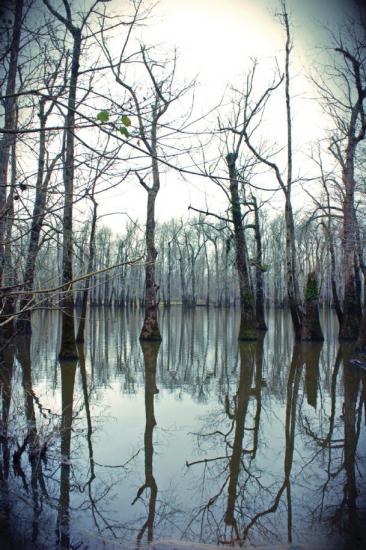Rufus Ward
Source - http://www.cdispatch.com/opinions/article.asp?aid=46273
 Chickasaw archaeologist Dr. Brad Lieb has referred to Tibbee Lake as one of very few special places that still exist, essentially unchanged, from the deep time of pre-contact Native American oral history. Photo by: Courtesy photo
Chickasaw archaeologist Dr. Brad Lieb has referred to Tibbee Lake as one of very few special places that still exist, essentially unchanged, from the deep time of pre-contact Native American oral history. Photo by: Courtesy photo
Friday night I was asked to tell stories at a "lock-in" for the West Point Episcopal Church's youth group. I was reminded of how, with all the interest in Facebook, Twitter and other forms of social media, the passing down of oral traditions from generation to generation by story tellers is being lost. There is one ancient sacred site in our area where place, oral traditions and archaeology merge with a heritage older than written history.
A couple of miles south of West Point on a gravel road is Tibbee Lake. Although it is near the creek, for which it is named, it appears to be an oxbow remnant of some prehistoric stream not only larger than Tibbee creek but once larger even than the Tombigbee River. As would be fitting for such a strange lake there is an oral tradition, a Chickasaw legend that may even stretch back thousands of years.
The story was recorded by E.T. Winston in 1931. It tells of how in the distant past a Chickasaw family once camped by a fallen tree in Tibbee swamp. In the early morning the mother and father departed to search for game or other food while leaving their young son and daughter at the camp site. Upon returning in the afternoon the parents were horrified to find the ground around their camp site had caved in, forming a huge lake. There where the lake covered the fallen tree and the place where their children had been left were two huge serpents swimming together. In fear of the cataclysm that had apparently turned their children into serpents the horrified parents fled and the lake was "shunned" from that day on.
How old is that story? It may date back thousands of years and have been orally passed down from prehistory by the Chickasaw until finally written down in 1931. How can we think the story might be that old when its early transmission was only oral? In excavations at the Moundville site near Tuscaloosa, Indian pottery vessels dating back to as early as AD 1200 have been found. One of the designs found on several vessels was that of a horned serpent. Might the children of Tibbee Lake represent the story behind that serpent?
According to Dr. Brad Lieb, Tribal Archaeologist with the Chickasaw Nation, "The story that has passed down to us is merely a fragment of a rich and living mythology that native peoples developed and maintained to explain their landscape, teach their cultural morals and values, and to pass along traditional spiritual knowledge. It was a tripartite worldview with an upper sky realm, the earth's surface which people occupy, and a watery underworld that was the realm of the dead, with each inhabited by powerful and dangerous spiritual and natural forces embodied by supernatural creatures which appeared to combine elements of various natural creatures."
In southeastern U.S. Native American mythology, deep water provided a portal to the underworld. These portals were places of not only great power but also great danger, and within them would be found supernatural creatures such as large serpents. Shamans could use those portals to enter the other realm to obtain spiritual knowledge or exotic materials with medical or spiritual properties. They could then return to this world and use their knowledge and newly obtained materials to help heal and spiritually guide their people.
Prior to the construction of the Tennessee-Tombigbee Waterway, high water would create a large whirlpool and the appearance of just such a portal at the mouth of Tibbee Creek. Tibbee Lake's proximity to the whirlpool, its strange appearance and unusual depth for an oxbow would have played into the ancient mythology and a need to explain the existence of the lake.
Hidden deep within an ancient forested swamp, Tibbee Lake would have been a portal to the underworld which had unexpectedly opened on an unsuspecting family. The legend of Tibbee Lake thus may well be a surviving form of the much older serpent tradition and the danger of its being a portal to the underworld would have caused it to be shunned.
Dr. Lieb has referred to Tibbee Lake as "one of very few special places that still exist, essentially unchanged, from the deep time of pre-contact Native American oral history."
For those interested in Native American history the short drive to Moundville is well worth it. Located nine miles south of Tuscaloosa, Moundville is an archaeological park and museum that is part of the museum system of the University of Alabama. Thanks to Dr. Brad Lieb for providing me with the Tibbee legend's background and possible linkage with the horned serpent of Moundville.